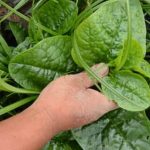Small yard vegetable gardens have become increasingly popular among urban and suburban gardeners looking to make the most of limited outdoor space. Whether you have a small backyard, balcony, or even just a sunny windowsill, growing your own vegetables can be a rewarding and sustainable way to provide fresh produce for your family.
In this article, we will delve into the many benefits of small yard vegetable gardens and provide tips and techniques for planning, planting, and maintaining a successful garden in a confined area.
One of the key advantages of small yard vegetable gardens is the ability to maximize space and sunlight to achieve a bountiful harvest. By carefully planning your garden layout and selecting compact, high-yield vegetable varieties, you can make the most of every square foot of available space.
Additionally, container gardening offers a versatile option for growing vegetables in pots and planters on patios, balconies, or even indoors. Vertical gardening techniques using walls and trellises can further optimize space by allowing plants to grow upwards instead of outwards.
In addition to providing fresh produce right at your doorstep, small yard vegetable gardens offer numerous other benefits such as promoting sustainability, reducing food miles, and enhancing the overall aesthetic appeal of your outdoor living space. With proper soil preparation, watering techniques, pest control strategies, and harvesting practices in place, you can enjoy a successful vegetable garden regardless of its size. Join us as we explore all the advantages that come with cultivating your own small yard vegetable garden.
Planning Your Small Yard Vegetable Garden Layout
When it comes to creating a successful small yard vegetable garden, one of the most important factors to consider is the layout. With limited space available, maximizing both sunlight exposure and the efficient use of every square inch is crucial.
To start, take note of the areas in your yard that receive the most sunlight throughout the day. Most vegetables require at least 6-8 hours of direct sunlight to thrive, so choosing a spot that meets this criteria is essential for a bountiful harvest.
One popular layout option for small yard vegetable gardens is creating raised beds. Raised beds not only help with proper drainage but also provide defined spaces for planting different crops. They can be designed in various shapes and sizes to fit your yard’s dimensions and can even be stacked on top of each other to create depth. Additionally, raised beds make it easier to amend and improve soil quality, which is vital for successful vegetable growth.
For those with extremely limited space in their yards, vertical gardening techniques can be a game-changer. Utilizing walls, fences, or trellises for growing vining crops like tomatoes, cucumbers, or beans not only saves space but also allows these plants to reach optimal sunlight levels. Vertical gardening opens up new possibilities for small yard vegetable gardens and provides an innovative solution for maximizing growth potential in confined areas.
| Small Yard Vegetable Gardens | Statistics |
|---|---|
| Number of Households with Small Yard Vegetable Gardens | 25% |
| Average Yield per Square Foot in Small Yards | 10-15 pounds |
Choosing the Right Vegetables for Small Yards
When it comes to small yard vegetable gardens, the key to success lies in choosing the right vegetables that are not only compact but also high-yielding. With limited space available, selecting varieties that can produce a bountiful harvest in a small area is essential for maximizing your garden’s potential. Here are some top choices for vegetables that are well-suited for small yards:
- Cherry Tomatoes: These petite tomato plants are perfect for containers or hanging baskets, taking up minimal space while still providing a plentiful crop of sweet and juicy tomatoes.
- Bush Beans: Compact and easy to grow, bush beans do not require staking and can be planted closely together in raised beds or containers, yielding an abundant supply of tender beans.
- Mini Bell Peppers: Ideal for small spaces, mini bell peppers offer the same crisp and sweet flavor as their larger counterparts but with a more manageable size plant that is perfect for container gardening.
In addition to these compact varieties, consider planting herbs such as basil, parsley, and chives that can thrive in small spaces and add fresh flavors to your meals. By strategically choosing vegetables that are suited for small yards, you can make the most out of your limited gardening area without sacrificing on the quantity or quality of your harvest.
When planning your small yard vegetable garden layout, it’s important to consider the growth habits of each plant and how they will interact with one another in terms of sunlight requirements and spacing. By selecting compact and high-yield varieties that complement each other well, you can create a thriving vegetable garden even in the smallest of spaces. With careful selection and planning, you can enjoy a productive and rewarding harvest from your own backyard oasis.
Container Gardening Options for Small Spaces
Container gardening is a fantastic option for individuals with limited space in their yards or balconies. This method allows gardeners to grow a variety of vegetables in pots and planters, maximizing the use of every available inch. The beauty of container gardening lies in its versatility and adaptability, making it perfect for small yard vegetable gardens.
Benefits of Container Gardening
One of the primary advantages of container gardening is its flexibility. Whether you have a tiny balcony, a narrow patio, or even just a window sill, you can create a bountiful vegetable garden with containers. Additionally, containers provide better control over soil quality and drainage compared to traditional garden beds. This means you can tailor the growing conditions to suit the specific needs of each vegetable variety you choose to cultivate.
Choosing the Right Containers
When selecting containers for your small yard vegetable garden, opt for pots that are large enough to accommodate the root systems of your plants while still fitting within your available space. Make sure the containers have sufficient drainage holes at the bottom to prevent waterlogged soil, which can lead to root rot.
You can get creative with your choice of containers by using recycled materials like buckets, crates, or even old tires – just be sure to clean them thoroughly before planting. Consider using vertical planters or hanging baskets to save even more space and add visual interest to your small yard vegetable garden.
Vertical Gardening Techniques
Maximizing Space With Vertical Gardening
Small yard vegetable gardens often face the challenge of limited space. However, vertical gardening techniques offer a practical solution to maximize space utilization. By growing vegetables vertically along walls, trellises, or fences, you can make the most of every inch of your small yard. This not only allows you to grow more plants but also creates an attractive and functional garden display.
Choosing the Right Vegetables for Vertical Growth
When implementing vertical gardening in your small yard vegetable garden, it is essential to select vegetables that are well-suited for vertical growth. Consider vining plants such as tomatoes, cucumbers, peas, and pole beans that naturally thrive when given vertical support. These plants not only take up less ground space but also benefit from better air circulation and sunlight exposure when grown vertically.
Designing a Vertical Garden Layout
To effectively utilize walls and trellises for vertical growth in your small yard vegetable garden, careful planning is necessary. Assess your available wall or fence space and choose the right trellis or support structures based on the needs of your selected vegetables.
Ensure that your vertical garden layout allows easy access for maintenance tasks such as watering, pruning, and harvesting. With proper design and organization, you can create a thriving vertical garden that enhances both the beauty and productivity of your small yard vegetable garden.
Tips for Soil Preparation and Maintenance in Small Yard Vegetable Gardens
Small yard vegetable gardens require special attention when it comes to soil preparation and maintenance due to limited space and resources. To ensure the success of your small yard vegetable garden, it is essential to start with healthy, nutrient-rich soil.
Begin by testing the pH levels of your soil and making any necessary adjustments to ensure optimal growing conditions for your vegetables. Adding compost or organic matter can help improve soil structure and fertility, providing a solid foundation for your plants to thrive.
In addition to enriching your soil with organic matter, proper maintenance is key to the long-term health of your small yard vegetable garden. Regularly monitoring soil moisture levels and providing adequate drainage are crucial for preventing waterlogged roots or dry, parched plants. Mulching around your vegetables can help retain moisture, suppress weeds, and regulate soil temperature, creating a more stable environment for growth.
When it comes to maintaining healthy soil in small yard vegetable gardens, crop rotation is another important practice to consider. Rotating your crops each season can help prevent nutrient depletion and reduce the risk of disease buildup in the soil.
By planning ahead and diversifying the types of vegetables you grow in different areas of your garden each year, you can optimize the health of your soil and maximize the productivity of your small space. With these tips for soil preparation and maintenance, you can create a thriving small yard vegetable garden that yields bountiful harvests throughout the growing season.
Watering and Irrigation Systems for Efficient Small Yard Vegetable Gardening
When it comes to small yard vegetable gardens, proper watering and irrigation systems play a crucial role in the success of your crops. With limited space, it’s important to ensure that every plant receives adequate water to thrive. Here are some tips and techniques for efficient watering in small yard vegetable gardens:
- Install a drip irrigation system: Drip irrigation is a highly efficient way to water your plants, delivering water directly to the roots where it’s needed most. This system can help conserve water and reduce the risk of overwatering or underwatering your vegetables.
- Use soaker hoses: Soaker hoses are another great option for small yard vegetable gardens. These porous hoses allow water to seep out slowly along their length, ensuring that the soil around your plants stays evenly moist without wasting water through runoff or evaporation.
- Set up a rainwater harvesting system: To further enhance the sustainability of your small yard vegetable garden, consider investing in a rainwater harvesting system. Collecting rainwater in barrels or containers can provide you with a free and eco-friendly source of water for your plants.
In addition to choosing the right watering method, it’s essential to establish a regular watering schedule based on the specific needs of your vegetables and the local climate conditions. Monitoring soil moisture levels and adjusting your irrigation practices accordingly can help prevent issues such as drought stress or root rot in your small yard vegetable garden.
Remember that consistency is key when it comes to watering small yard vegetable gardens. By implementing an efficient irrigation system and staying attuned to the needs of your plants, you can ensure healthy growth and bountiful harvests from even the tiniest gardening spaces.
Pest Control Strategies for Protecting Your Small Yard Vegetable Garden
When it comes to maintaining a small yard vegetable garden, one of the key challenges that gardeners face is pest control. Pests such as aphids, caterpillars, and beetles can quickly devastate a small crop if not properly managed. However, there are several effective strategies that can help protect your small yard vegetable garden from these unwanted visitors.
One of the most important pest control strategies for small yard vegetable gardens is practicing good garden hygiene. This includes regularly removing weeds, fallen leaves, and other debris that can harbor pests. By keeping your garden clean and well-maintained, you can reduce the likelihood of pests taking up residence in your plants.
Another effective pest control method for small yard vegetable gardens is companion planting. Certain plants have natural repellent properties that can help deter pests from your vegetables. For example, planting marigolds around your vegetable garden can help repel nematodes and other harmful insects. Additionally, attracting beneficial insects such as ladybugs and lacewings can also help keep pest populations in check.
Implementing physical barriers such as row covers or netting can also be an effective way to protect your small yard vegetable garden from pests. These barriers create a physical barrier between your plants and potential invaders, preventing them from causing damage to your crops. By combining multiple pest control strategies and staying vigilant in monitoring your garden, you can successfully safeguard your small yard vegetable garden from common pests.
| Pest Control Strategy | Benefits |
|---|---|
| Companion Planting | Natural repellent properties help deter pests |
| Good Garden Hygiene | Reduces likelihood of pests taking up residence |
| Physical Barriers | Create a protective barrier between plants and invaders |
Harvesting and Enjoying the Fruits of Your Labor
Small yard vegetable gardens can be incredibly rewarding, providing fresh produce right at your doorstep. As you venture into the world of small yard vegetable gardening, it’s important to remember that the ultimate goal is to harvest and enjoy the fruits of your labor. With careful planning and a little bit of effort, you can ensure a bountiful harvest even in limited space.
One key tip for successful vegetable harvesting in small yards is to maximize the use of vertical gardening techniques. By utilizing walls, trellises, and other vertical structures, you can grow more plants in a smaller footprint. This not only saves space but also allows for better air circulation and sunlight exposure for your vegetables, leading to healthier plants and higher yields.
Additionally, implementing efficient watering and irrigation systems is crucial for maintaining a thriving small yard vegetable garden. Proper hydration is vital for plant growth and production. Consider installing drip irrigation systems or using self-watering containers to ensure that your vegetables receive adequate moisture without wasting water. By staying on top of watering needs and adjusting as necessary, you can help your small yard vegetable garden flourish throughout the growing season.
In conclusion, while small yard vegetable gardens may pose challenges in terms of space limitations, with careful planning and attention to detail, you can successfully cultivate a productive garden right in your backyard. From choosing compact varieties to maximizing vertical space and implementing efficient watering systems, there are numerous strategies you can employ to make the most out of your small yard vegetable garden.
The joy of harvesting fresh vegetables from your own garden will surely make all the hard work worthwhile.
Frequently Asked Questions
How Do You Make a Vegetable Garden in a Small Space?
Creating a vegetable garden in a small space can be quite easy and rewarding. Utilizing vertical gardening techniques such as trellises or wall planters can help maximize space. Choosing compact varieties of vegetables that can be grown close together is also important.
What Veggies Grow in a Small Garden?
Several vegetables thrive in small gardens due to their compact size and high yield. Some examples include cherry tomatoes, lettuce, radishes, green beans, peppers, and herbs like basil and cilantro. These veggies not only grow well in limited spaces but also provide a continuous harvest throughout the season.
What Vegetables Grow Well in Small Raised Garden?
Vegetables that do well in small raised gardens are those with shallow root systems such as lettuce, spinach, radishes, and herbs like parsley or chives. These plants are perfect for raised beds because they don’t require deep soil and benefit from the improved drainage offered by raised garden beds.
Such vegetables can flourish in confined spaces without compromising on quality or quantity of the harvest.

If you’re looking to get into vegetable gardening, or are just looking for some tips on how to make your current garden better, then you’ve come to the right place! My name is Ethel and I have been gardening for years. In this blog, I’m going to share with you some of my best tips on how to create a successful vegetable garden.





